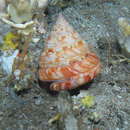en
names in breadcrumbs


Pleurotomarioidea is a superfamily of small to large marine gastropods included in the order Pleurotomariida of the subclass Vetigastropoda.[2]
These are the slit shells, originally named Pleurotomariacea, in keeping with the convention for naming superfamilies at the time. This updated version of the name for the taxon is usually used by students of the living Mollusca. Paleontologists often still use the name Pleurotomariacea instead.
Forming the first evidence of crown-group gastropods when they appeared in the Upper Cambrian, the fossil record of the Pleurotomarioideans has no substantial gaps until today. The group took quite a hit at the Cretaceous–Paleogene boundary (K–T boundary), with only the Pleurotomariidae surviving the Cretaceous–Paleogene extinction event – and then only in deep waters.[3]
Living representatives of the group were first discovered in the mid-19th century, and their unusual mix of primitive and derived characters perplexed biologists. The researchers originally responded by re-working their ideas of how the gastropod lineage evolved, but with the introduction of cladistics, attempts are currently underway to fit them into a molluscan phylogeny.[3]
J. D. Stilwell et al. 2004[4] put the Pleurotomarioidea in the order Archaeogastropoda which is included in the Prosobranchia.
The following families have been recognized in taxonomy by Tracey at al. (1993)[5] and in the taxonomy of Bouchet & Rocroi (2005):
Bouchet and Rocroi (2005) includes the Pleurotomarioidea in the Vetigastropoda, following Ponder and Lindberg (1997), but refers to the Vetigastropoda simply as a clade.
P. J. Wagner 2008[6] includes the superfamily Pleurotomarioidea, (ex Pleurotomariacea) in the suborder Pleurotomariina and superorder Vetigastropoda. This is an as yet (September 2010) unpublished opinion by Wagner.[6]
{{cite book}}: |first1= has generic name (help) Pleurotomarioidea is a superfamily of small to large marine gastropods included in the order Pleurotomariida of the subclass Vetigastropoda.
These are the slit shells, originally named Pleurotomariacea, in keeping with the convention for naming superfamilies at the time. This updated version of the name for the taxon is usually used by students of the living Mollusca. Paleontologists often still use the name Pleurotomariacea instead.
Pleurotomarioidea est une super-famille de mollusques gastéropodes de l'ordre des Archaeogastropoda.
Selon World Register of Marine Species (24 octobre 2014)[1] :
Pleurotomarioidea est une super-famille de mollusques gastéropodes de l'ordre des Archaeogastropoda.
Pleurotomarioidea Swainson, 1840 è una superfamiglia di molluschi gasteropodi della sottoclasse Vetigastropoda.[1]
La superfamiglia Pleurotomarioidea include alcuni dei primi gasteropodi che compaiono nella documentazione fossile; i suoi membri sono conosciuti per la prima volta dall'alto Cambriano e persistono fino ai giorni nostri, fornendo così importanti informazioni sulla storia evolutiva della classe Gastropoda. I Pleurotomarioidea raggiunsero la maggiore diversità numerica e morfologica durante il Paleozoico e dominarono le faune globali dei gasteropodi marini di acque basse durante il Paleozoico e il Mesozoico. Una sola famiglia, i Pleurotomariidae, sopravvissero alla estinzione di massa del Cretaceo-Paleocene.[2]
Questi gasteropodi mostrano un accoppiamento di organi interni, come il Ctenidio bipennata, che è stato successivamente perso o ridotto nella maggior parte dei gruppi di gasteropodi moderni, per questa ragione essi sono generalmente considerati "primitivi".[3]
I pleurotomarioidi sono caratterizzati dalla presenza di una fascia a spirale nella conchiglia chiamata selenizona che si trova di solito vicino alla sua periferia. La selenizona viene generata quando la fenditura presente nel margine aperturale si chiude durante la crescita del guscio. Questa fessura è utilizzata per il flusso d'acqua esalante dalla cavità del mantello, con flussi inalanti situati su entrambi i lati.[3]
La superfamiglia Pleurotomarioidea comprende 9 famiglie di cui otto estinte ed una sola tutt'ora esistente:[1]
Pleurotomarioidea Swainson, 1840 è una superfamiglia di molluschi gasteropodi della sottoclasse Vetigastropoda.